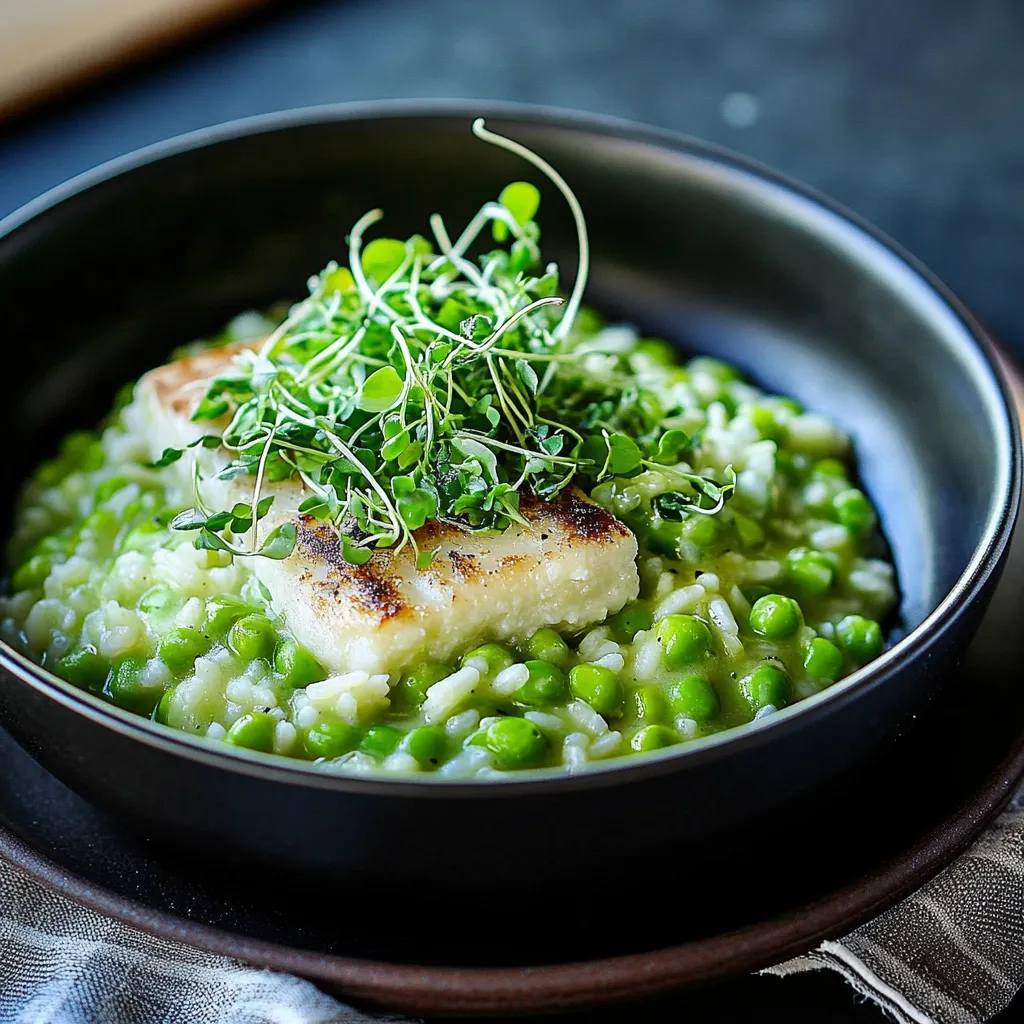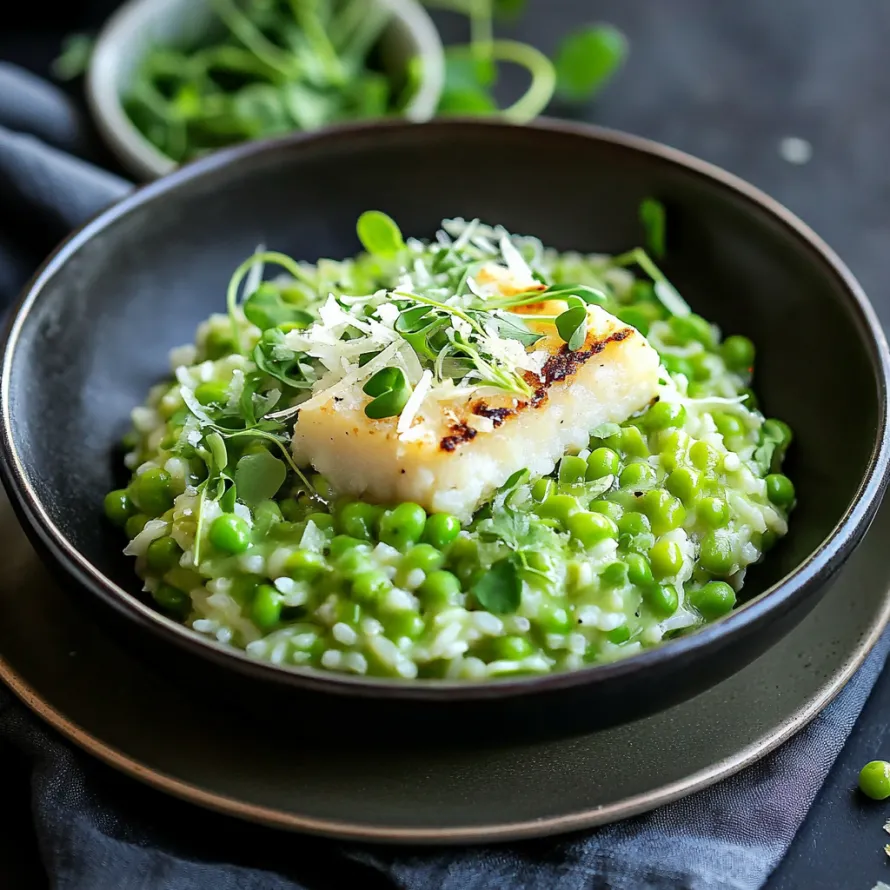 Pin
Pin
This lush pea risotto turns everyday items into a velvety, indulgent meal that showcases sweet spring peas against a rich background of perfectly done arborio rice. I stumbled upon this dish during my travels through Northern Italy and have tweaked it in my own kitchen for years now.
This risotto became my go-to specialty after I made it for a dinner with friends where even my pickiest pal asked how to make it. There's something about how the sweet peas mix with the rich cheese that makes everyone want more.
What You'll Need
- Arborio rice: Gives you that wonderful creamy feel without turning to mush
- Vegetable broth or chicken stock: Forms the base flavor; try making your own for the tastiest results
- Fresh or frozen peas: Both do the job nicely; grab frozen ones to save some prep time
- Pecorino cheese: Brings a nice salty kick that works against the peas' sweetness
- Lemon zest: Adds a fresh pop to the whole dish; go for organic lemons if you can
- Fresh mint: Adds unexpected zip; always pick the brightest green leaves
- Truffle oil: Takes this dish from basic to amazing; you only need a tiny bit
How To Make It
- Get Your Broth Ready:
- Heat your veggie or chicken broth in a pot until it's steamy but not bubbling. Keep it warm while you cook since cold liquid will mess up how the rice releases its starch.
- Cook Your Flavor Base:
- Warm olive oil in a heavy pot on medium-low then toss in shallots and garlic. Let them cook slowly for around 5 minutes until they smell good and look golden. This slow cooking builds all your base flavors.
- Get The Rice Going:
- Put your arborio rice in the pot and keep stirring for one minute. Listen for a little crackling noise as the rice toasts which helps it stay firm while cooking.
- Start Adding Liquid:
- Pour in wine and stir till it's gone. This adds flavor and helps the rice open up. Then add your first cup of hot broth and stir now and then until it soaks in, about 5 minutes, before adding more.
- Keep The Rhythm Going:
- Add more broth one cup at a time, waiting till each bit gets mostly soaked up before adding the next. All this stirring lets out starch that makes everything creamy. This whole part takes roughly 20 minutes.
- Fix Up Your Peas:
- While your risotto cooks, get your peas ready. If they're fresh, dunk them in salty boiling water for 2-3 minutes till bright green and soft. Set half aside then blend the rest with water and olive oil until smooth.
- Mix In The Good Stuff:
- When your rice feels soft but still has a tiny bit of firmness, mix in the cheese, lemon zest, whole peas, and pea puree. The hot risotto will melt the cheese right away, making everything super creamy. Mix in most of the mint but save some for topping.
- Final Touches:
- Try it and add more salt, pepper, or lemon if needed. Scoop into warm bowls and finish with a tiny drizzle of truffle oil and the leftover fresh mint.

I first cooked this risotto when my Italian grandma came to visit and she said it took her back to spring days in Milan. The way the bright green pea mix swirls through the creamy rice looks beautiful and creates flavor layers that unfold with every bite.
Prep Ahead Options
While risotto is best served right away, you can get parts ready ahead of time. Cook peas and make the pea puree up to two days early and keep them in the fridge. You can also partly cook the risotto for about 15 minutes, then spread it on a tray to cool down. Pop this half-cooked rice in the fridge, then finish it with hot broth and mix-ins just before you want to eat. Fully cooked risotto will last in the fridge for three days tops, though it gets thicker. Just warm it up slowly with extra broth until it's creamy again.
What To Serve With It
This fresh risotto goes great with crisp white wines like Pinot Grigio or Vermentino that match the sweet peas without being too much. For a full meal, try it with pan-seared scallops whose browned outsides work really well with the smooth risotto. A simple arugula salad with lemon and olive oil adds a nice bitter note that cuts through the richness. In colder weather, this risotto tastes amazing topped with crispy pancetta or prosciutto that adds a nice crunch against the creamy base.
Changing With The Seasons
While you can use frozen peas any time of year, this dish really shines in late spring when fresh peas are super sweet. In summer, try swapping half the peas for fresh corn kernels for a different twist. Fall is perfect for mixing in some pumpkin puree instead of some broth, and winter calls for extras like crispy sage or a spoonful of mascarpone. The basic recipe works so well you can make countless seasonal changes while keeping that comforting feel.

Make this when you want to wow your guests—it's fancy but still feels like comfort food.
Recipe Q&A
- → Can I use frozen peas instead of fresh for this risotto?
Absolutely, frozen peas work great in this meal and they're actually listed as an option in the directions. They're often easier to find and can go straight into your pot without pre-cooking. Frozen peas are usually top quality since they're packaged right after picking.
- → What can I substitute for white wine in risotto?
If you don't want to cook with wine, just mix water with a teaspoon of lemon juice as the recipe suggests. This gives you that nice tang that cuts through the richness. You could also try veggie broth with a tiny bit of vinegar or grab some non-alcoholic white wine at the store.
- → Why is stirring risotto so important?
Giving your risotto a stir every minute or so pulls the starch out from the arborio rice, making it nice and creamy without adding any actual cream. It also makes sure everything cooks evenly and doesn't stick to your pot. All that stirring lets the rice slowly drink up the broth, which makes it taste and feel just right.
- → How do I know when my risotto is perfectly cooked?
The best risotto should be 'al dente' - soft but with a tiny bit of firmness when you bite it. The whole dish should look creamy and flow a little (Italians say 'all'onda' which means wave-like), not thick or dry. When it's done right, it'll spread out on your plate instead of sitting in a pile. This usually takes about 20 minutes of cooking.
- → What can I serve with pea risotto?
This dish works great by itself or as a side. For extra protein, try the quick-fried fish or scallops mentioned, or throw in some Spanish chorizo for a smoky touch. It also goes really well with a simple green salad, some roasted asparagus, or those sauteed mushrooms that the recipe lists as an optional add-in.
- → Can I make risotto ahead of time?
Though risotto tastes best right after cooking, you can do some prep work ahead. Cook it until it's about three-quarters done, then spread it out on a cookie sheet to cool down fast. Put it in the fridge until you need it, then finish it up with hot broth and the rest of your ingredients just before eating. It won't be quite as amazing as freshly made, but it's a good trick when you're having guests over.
